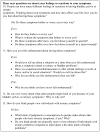Beyond incontinence: the stigma of other urinary symptoms
- PMID: 20735505
- PMCID: PMC3032268
- DOI: 10.1111/j.1365-2648.2010.05422.x
Beyond incontinence: the stigma of other urinary symptoms
Abstract
Aim: This paper is a report of a study conducted to characterize the stigma of urinary frequency and urgency and differentiate it from the stigma of incontinence and to describe race/ethnic and gender differences in the experience of stigma among a diverse sample of individuals.
Background: Lower urinary tract symptoms, including frequency, urgency and incontinence, are susceptible to stigma, but previous stigma research has focused almost exclusively on incontinence.
Method: The Boston Area Community Health Survey is a population-based, random sample epidemiological survey of urologic symptoms (N = 5503). Qualitative data for this study came from in-depth interviews conducted between 2007 and 2008 with a random subsample of 151 black, white and Hispanic men and women with urinary symptoms.
Findings: Respondents reported stigma associated with frequency and urgency - not just incontinence. The stigma of frequency/urgency is rooted in social interruption, loss of control of the body, and speculation as to the nature of a non-specific 'problem'. Overall, the stigma of urinary symptoms hinged upon whether or not the problem was 'perceptible'. Men felt stigmatized for making frequent trips to the bathroom and feared being seen as impotent. Women feared having an unclean body or compromised social identity. Hispanic people in particular voiced a desire to keep their urinary symptoms a secret.
Conclusion: The stigma of urinary symptoms goes beyond incontinence to include behaviours associated with frequency and urgency. Healthcare practitioners should assess for stigma sequelae (e.g. anxiety, depression) in individuals with frequency and urgency, and stress treatment options to circumvent stigmatization.
© 2010 The Authors. Journal of Advanced Nursing © 2010 Blackwell Publishing Ltd.
Figures
Similar articles
-
Is abuse causally related to urologic symptoms? Results from the Boston Area Community Health (BACH) Survey.Eur Urol. 2007 Aug;52(2):397-406. doi: 10.1016/j.eururo.2007.03.024. Epub 2007 Mar 16. Eur Urol. 2007. PMID: 17383083 Free PMC article.
-
Prevalence of lower urinary tract symptoms and effect on quality of life in a racially and ethnically diverse random sample: the Boston Area Community Health (BACH) Survey.Arch Intern Med. 2006 Nov 27;166(21):2381-7. doi: 10.1001/archinte.166.21.2381. Arch Intern Med. 2006. PMID: 17130393
-
Prevalence of urinary incontinence symptoms among black, white, and Hispanic women.Obstet Gynecol. 2002 Apr;99(4):572-5. doi: 10.1016/s0029-7844(01)01781-1. Obstet Gynecol. 2002. PMID: 12039113
-
Occurrence rates and predictors of lower urinary tract symptoms and incontinence in female athletes.Urologia. 2010 Apr-May;77(2):139-46. Urologia. 2010. PMID: 20890872 Review.
-
Urinary incontinence among older women. Measurement of the effect on health-related quality of life.J Gerontol Nurs. 2003 Jul;29(7):13-9. doi: 10.3928/0098-9134-20030701-05. J Gerontol Nurs. 2003. PMID: 12874935 Review.
Cited by
-
Is a behavioral treatment for urinary incontinence beneficial to prostate cancer survivors as a follow-up care?J Cancer Surviv. 2017 Feb;11(1):24-31. doi: 10.1007/s11764-016-0557-0. Epub 2016 Jun 24. J Cancer Surviv. 2017. PMID: 27341843 Free PMC article.
-
King's Health Questionnaire to assess subjective outcomes after surgical treatment for urinary incontinence: can it be useful?Int Urogynecol J. 2017 Jan;28(1):139-145. doi: 10.1007/s00192-016-3089-2. Epub 2016 Jul 16. Int Urogynecol J. 2017. PMID: 27423456
-
Experiences of intimate continence care and the impact on the family dyad relationship for people living at home with dementia and their co-resident family members.Dementia (London). 2022 Jul;21(5):1556-1573. doi: 10.1177/14713012221076667. Epub 2022 Apr 21. Dementia (London). 2022. PMID: 35446139 Free PMC article.
-
Sacral neuromodulation therapy for urinary and defecatory disorders: experience in a Latin American public hospital.Rev Bras Ginecol Obstet. 2024 Mar 15;46:e-rbgo11. doi: 10.61622/rbgo/2024AO11. eCollection 2024. Rev Bras Ginecol Obstet. 2024. PMID: 38765538 Free PMC article.
-
Health risks associated with urinary incontinence among older Korean Americans living in subsidized senior housing.Ethn Health. 2025 Jan;30(1):85-97. doi: 10.1080/13557858.2024.2413358. Epub 2024 Oct 7. Ethn Health. 2025. PMID: 39373267
References
-
- Abrams P, Cardozo L, Fall M, Griffiths D, Rosier P, Ulmsten U, Van Kerrebroeck P, Victor A, Wein A. The standardisation of terminology in lower urinary tract function: report from the standardisation sub-committee of the International Continence Society. Urology. 2003;61(1):37–49. - PubMed
-
- Anglin DM, Link BG, Phelan JC. Racial differences in stigmatizing attitudes toward people with mental illness. Psychiatr Serv. 2006;57(6):857–62. - PubMed
-
- Barry MJ, Link CL, McNaughton-Collins MF, McKinlay JB. Overlap of different urological symptom complexes in a racially and ethnically diverse, community-based population of men and women. BJU Int. 2008;101(1):45–51. - PubMed
-
- Brittain KR, Shaw C. The social consequences of living with and dealing with incontinence--a carers perspective. Soc Sci Med. 2007;65(6):1274–83. - PubMed
-
- Chiverton PA, Wells TJ, Brink CA, Mayer R. Psychological factors associated with urinary incontinence. Clin Nurse Spec. 1996;10(5):229–33. - PubMed
Publication types
MeSH terms
Grants and funding
LinkOut - more resources
Full Text Sources
Medical



